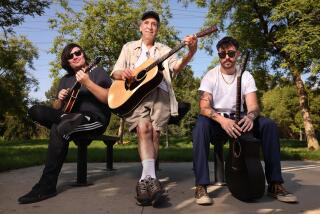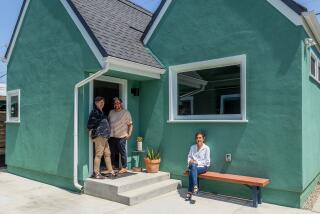A Loving Lesson, for Old and Young Alike
- Share via
LA MESA — It was raining, and Ruth Leiderman’s class of gifted third- through sixth-graders was looking eagerly out the wet window panes of Northmont Elementary School’s Room 18. Meanwhile, a griddle was heating, waiting to cook potato latkes, and one wall was covered with a colorful, cut-paper design of a menorah and the message “Happy Chanukah, Adopted Grandparents.”
Soon a van and a station wagon pulled up, and the children streamed through the door to help 12 elderly residents of San Diego Hebrew Home make their way slowly into the waiting warmth.
This adopt-a-grandparent program began two years ago when Leiderman, then Ruth Gottfeld, began teaching the gifted class (one of several in the school system where students can be in the same classroom for four years). Gary Leiderman, assistant administrator of the home, suggested that her class might like to visit with residents. Soon, with the help of Alice Avigal, activities coordinator of the home, the program was under way. And it has worked out very well, said Ruth Leiderman--for everyone. Now all 24 children in her class have an adopted grandparent at the home whom they see once a month--and the Leidermans have been married since last month.
Developing Friendships
The length of time students spend in her class works to the advantage of a program like this, said Leiderman, 34. “It works out well for the students and for the elders because there is time to develop a real relationship. That is what is really unique about this adopt-a-grandparent program.”
The youngsters go to the home once a month to spend time with their special friends, and each time they take a gift they’ve made in class--a card, or perhaps a May Day basket, a mobile or a paper weight with a photo inside. And the senior citizens reciprocate with cards or small tokens of appreciation.
The children and residents often work on arts and crafts together, or do exercises led by the activities coordinator, like the one called Parachute (sitting in a circle holding a real parachute, and billowing it up and down for muscle coordination), or a dance exercise. But mostly, they just talk, the way all friends do.
According to staffer Denice Levinson, “The elders look forward to the children’s visits, and have a countdown . . . ‘Five days to go until the kids come, four days . . .’ ”
“Since there is only one Jewish child in the class, the elders are exposed to children who aren’t Jewish, and this is good for them,” Avigal said. “It is more than an intergenerational experience, it is also interculture. The children in turn learn about the Jewish traditions--and also what it’s like to have a Jewish grandmother! They are always buying candy for the children.”
The recent classroom visit was eagerly anticipated--it’s the one day in the year that the senior citizens visit the school.
Julia Pochter, 94, came in first, on the arm of Carrie Ross, 10. She smiled widely as she said proudly, “This is my granddaughter, Carrie.” Carrie held the woman’s cane and helped her sit down. Then Carrie handed her a small tissue-wrapped gift. She carefully peeled back the wraping to reveal a clay dreidel, a toy used traditionally at Hanukkah.
“Oh, I’ll give it some day to my sister and her children and her children’s children, and it’ll be passed on. I love children. I couldn’t have any,” said Pochter. Then she pulled a photo from her purse and handed it to Carrie. It was of the two of them, taken at their last get-together.
Soon, the ambulatory residents of the home (average age is 90, Levinson said) sat in the room at small tables with their adopted grandchildren and the other students whose grandparents were not able to make the trek.
The festivities began with a short explanation of the meaning of the lighting of each candle on the menorah during the eight days of Hanukkah.
“Today is the fourth day; the candle today is for mercy,” said Avigal.
Karen Harness, who will soon replace Avigal as the home’s activities coordinator, played traditional music on her guitar, accompanying the singing. Then, along with the eating of the latkes, cookies and punch, the talking began.
How They Felt
Lenna Saperstein, 86, and Michael Shultz, 11, reminisced about their first meeting. “I was shy,” said Michael.
“Yes,” said Saperstein. Her delicate gold earring gently moved as she talked. “He wrote notes to me at first. He said I was the nicest lady he ever met. He is so sincere and polite. I wouldn’t disappoint him for the world.”
Saperstein came here from New York two years ago and has no family in San Diego. “The affection you would give to your own, you can give to these children,” she said. “It’s true devotion. And people full of love, like Michael, come from homes of harmony.”
Leiderman recalled the first day students met their grandparents (all matched by her and Avigal). “Each child worked out a set of questions to ask his or her grandparent,” she said. “Then they interviewed the older person, and each child came to the microphone in front of everyone and introduced the new adopted grandparent.”
Carrie said that when she interviewed Pochter, she asked her how old she was and where she was born. Also, she asked, was she married? Did she have children?
“I learned grandparents do need care,” said Carrie. “They are really special people. They can do things even though they are older. We should treat them as equals.”
Minna Huovila, 10, said, “It was scary at first. I didn’t know how to act. I was anxious. Now, it’s like I really know my adopted grandmother, Anna (Garren) well. I like going to the home, seeing different Jewish people, knowing their religion.”
The children were a little hesitant the first day, Leiderman said. “They weren’t used to being around much older people. After all, their grandparents are mostly in their 50s--but the residents of the home are in their 90s.
“The older people, on the other hand, were more open. They hugged and kissed the children.”
Important Lessons
Leiderman said she, too, has made an adjustment and has learned a lot about being around elderly people.
She said the class has “dealt with the stereotype of age. We talked in the beginning about how older people are portrayed. The students said they thought of older people as cranky or ornery. But later, after the visits, some students said, ‘We don’t feel that way any more.’ And so, we are breaking the stereotype, and our perception of the elderly.”
Jeff Poppe, 11, sat next to his adopted grandfather’s wheelchair. Harry Zimmerman, 84, said he has won a wheelchair dance contest, and claims that he was born in the house where the great Chicago Fire began. Zimmerman also tells a lot of World War II stories, which his adopted grandson listens to attentively.
Jeff said their friendship began when Zimmerman first shook his hand and helped him feel at ease.
Despite the fact that the elders are all Jewish, “I don’t bring faith into it--except during Hanukkah,” Leiderman said.
“I bring in the cultural side of it. For example, the children have seen the elders making menorahs and they had fun participating in a carnival at Purim,” a harvest festival celebrated in the spring, complete with costumes.
Preparing for Inevitable
Leiderman acknowledges the importance of preparing the children for sickness or the death of their adopted grandparents.
“We have tried to prepare the kids,” she said. “I told them these older people have had long lives--that they are the small percentage of people who have lived longer--that a death could occur at any time, because they are so fragile. This year, in fact, Julia had a massive heart attack, and we tried to prepare Carrie, but she pulled through.”
Parents of the students have been very supportive, said Leiderman. “In fact, several mothers help drive the children to the home for visits and help with the program.”
And some of the students volunteered at the home during their summer vacation.
More to Read
Sign up for Essential California
The most important California stories and recommendations in your inbox every morning.
You may occasionally receive promotional content from the Los Angeles Times.













